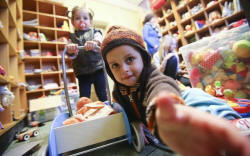|
Five ways to hard-wire
children for a lifetime of giving
 Send a link to a friend
Send a link to a friend
 [November 30, 2016]
By Chris Taylor [November 30, 2016]
By Chris Taylor
NEW
YORK(Reuters) - (The writer is a Reuters contributor. The opinions
expressed are his own.)
As any parent knows, most children seem to be wired for one thing:
Getting, getting, getting.
Then there are kids like Kai Martin.
The 9-year-old Arizonan is counting down to the holidays with a special
kind of Advent calendar: Every day in December he is putting a food item
in a box, which will be delivered to a local shelter at Christmas.
Some of that generous nature comes from Kai himself. But he is also
being hard-wired for giving by his mom, Shannon Bodnar. Just as her own
parents inspired her to give - taking her along on trips to give holiday
toys to families in need, when she was just 7 - she is now coding the
philanthropic instinct into her own child's brain.
"He has always been a philanthropic kid," said Bodnar, a technology
marketer in Chandler, Arizona. "I am excited to see what kind of
charitable adult he will become."
Fostering children's charitable impulses helps boost their wellness and
self-esteem by showing them they can make a difference in someone's
life, according to Carol Weisman, author of "Raising Charitable
Children." It also helps them develop leadership skills, which are
likely to serve them well in their personal and professional lives,
Weisman said.

Researchers say that by making philanthropy a habit early in life, while
the brain is still developing, we can establish neural pathways that
persist into adulthood.
"The path to doing this is to help them have experiences of generosity
that they internalize as lasting changes in their brains," said Dr. Rick
Hanson, a psychologist and author of the book "Hardwiring Happiness."
That means thinking about it, talking about it and repeating it, so that
a generous instinct becomes second nature. Like a finicky plant, it
needs the right conditions to thrive.
That is where parents come in: Kids whose parents discuss giving with
them are 20 percent more likely to give themselves, according to one
study by the University of Indiana's Lilly Family School of
Philanthropy.
Parents certainly seem to be doing our part: 87 percent of kids report
that their parents encouraged them to give away toys or clothes,
according to the 2016 Parents, Kids & Money survey by Baltimore-based
money managers T. Rowe Price. And 69 percent were encouraged to give
cash to charity, as well.

But, as any parent also knows, getting kids to do as they are told is
akin to pushing a recalcitrant donkey. Here is some advice to
successfully plant seeds of philanthropic behavior:
1. Use the holidays as a teachable moment.
The end of the year is when families do much of their annual giving.
"Tell kids how much money you have to give away, and then discuss what
causes are important to you as a family," said Weisman. "If the children
are very small, maybe even use Monopoly money."
[to top of second column] |

Children receive toys at a refugee shelter run by German charity
organisation Arbeiter Samariter Bund ASB in Berlin, Germany,
December 12, 2015. REUTERS/Hannibal Hanschke

2. Make sure they see family giving.
These days, much of your charity may be done through credit-card
donations or automatic withdrawals, which your kids might not witness.
Rectify that by involving them in the process and having them click on
that donation button themselves, advises Weisman.
3. Make a mindfulness practice out of it.
If your child gives a buck to a homeless person and then immediately
forgets about it, you probably have not fostered any long-lasting habit.
So have your child think not only about what good that dollar will do,
but how the act of giving made them feel. "Neurologically, this simple
practice - taking only half a dozen seconds or longer - will increase
the encoding of generosity," said Hanson.
4. Start with giving time.
Obviously young children do not have much money of their own, so begin
cultivating the charitable impulse by having children give of their
time.
Shannon Bodnar sits down every year and talks with son Kai about which
causes they feel strongly about, so they can start allocating their
volunteer time. "Then you can start talking about giving money as well -
such as fundraising or donating a portion of their allowance," Bodnar
said.
5. Go beyond the holidays.
While Bodnar may have provided the initial spark for giving, Kai has
taken it to bonfire levels - and not just at Christmas time, either.

His birthday is in the spring, and he has refused gifts for the last
four years, instead asking people to donate to the local leukemia and
lymphoma society. Using the charitable fundraising site Crowdrise, he
has amassed a total of $6,700.
(Editing by Beth Pinsker and Andrew Hay)
[© 2016 Thomson Reuters. All rights
reserved.] Copyright 2016 Reuters. All rights reserved. This material may not be published,
broadcast, rewritten or redistributed.
 |